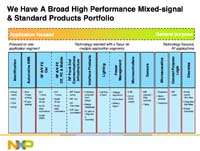 A couple of weeks ago I spent a morning at NXP’s innovation day. The first slightly surreal aspect of it was that it was in a building I used to work in. After I left VLSI Technology, NXP (then Philips Semiconductors, don’t forget that final “s”) made a successful bid for VLSI and then consolidated their operations in silicon valley into the 4 buildings that VLSI had purchased when its landlord had gone bankrupt. After several rounds of layoffs there are apparently just 250 people working in buildings that I would guess could accommodate 10 times that many people.
A couple of weeks ago I spent a morning at NXP’s innovation day. The first slightly surreal aspect of it was that it was in a building I used to work in. After I left VLSI Technology, NXP (then Philips Semiconductors, don’t forget that final “s”) made a successful bid for VLSI and then consolidated their operations in silicon valley into the 4 buildings that VLSI had purchased when its landlord had gone bankrupt. After several rounds of layoffs there are apparently just 250 people working in buildings that I would guess could accommodate 10 times that many people.
Since NXP was spun out of Philips they have divested themselves of their wireless business (sold to ST and now consolidated into ST-Ericsson) and their low end analog business (to Virage). They are also spinning out their digital TV and set-top-box and combining it with Trident. This means that the remaining part of the business can focus on high performance mixed-signal designs, especially ones requiring non-standard manufacturing processes that you can’t just order up from the foundries.
If you want some numbers, NXP grew 20% in Q3 from last year to just over $1B (which I must say is not bad in the current economic climate). They made $147M on that. They also have just over $1B in cash, which apparently is more than all but a handful of other semiconductor companies (although, of course, many semiconductor companies are integrated into larger electronics companies, especially in Asia).
By high performance mixed signal NXP means a combination of SoC technology, riding Moore’s law in the usual way, and mixed in with high-performance analog, sensors, special packages, high-voltage, RF, biological interfaces. In many of the submarkets of this NXP is already #1 and, with mixed signal expertise being scarce, likely to stay that way.
The most interesting of the products that they demoed was a cochlear implant where the left and right ears implants could communicate with each other using very short range wireless technology. Cochlear implants are put inside deaf people’s skulls to interface directly to nerves. Gradually the deaf person (usually a child) can start to hear as the brain works out what to do with those weird electrical signals that suddenly started to appear. I have a friend whose daughter was born deaf and has a cochlear implant and the transformation is nothing short of incredible. But putting two implants, one for each ear, and having them be able to communicate with each other, makes for even better comprehension. With an inductive interface too, it is possible to use a small box that takes Bluetooth and communicates inductively with the implants, allowing deaf people to use the phone or listen to music much more easily (it’s too power hungry just to put a bluetooth receiver in the implant, remember it’s hard to change the battery).
Another interesting technology is LED lighting. This is not ready to show up in yor home yet, but it is ready for street lights and close to being ready for commercial applications, where a bulb burning out is not just an annoyance but an expense. Although they use less power, and so save money there, the real saving comes from the fact that they last so much longer.
